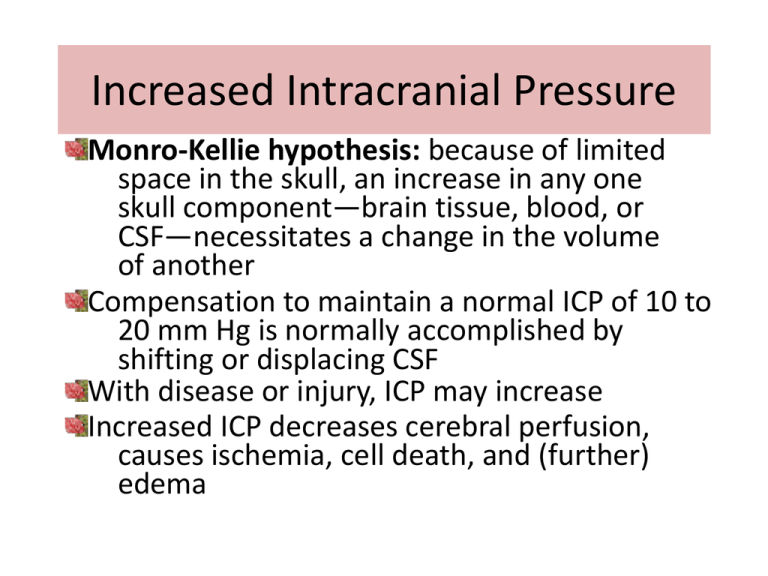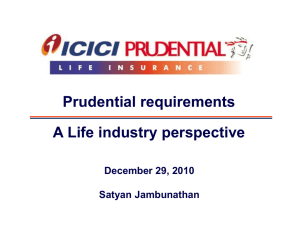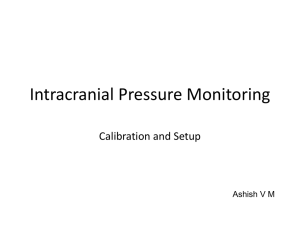Early Signs of ICP
advertisement

Increased Intracranial Pressure Monro-Kellie hypothesis: because of limited space in the skull, an increase in any one skull component—brain tissue, blood, or CSF—necessitates a change in the volume of another Compensation to maintain a normal ICP of 10 to 20 mm Hg is normally accomplished by shifting or displacing CSF With disease or injury, ICP may increase Increased ICP decreases cerebral perfusion, causes ischemia, cell death, and (further) edema ICP and CPP Normal ICP is 10 to 20 mmHg CCP (cerebral perfusion pressure) is closely linked to ICP CCP = MAP (mean arterial pressure) – ICP Normal CCP is 70 to 100 A CCP of less than 50 results in permanent neuralgic damage Early Signs of ICP The earliest sign of increasing ICP is a change in LOC. Slowing of speech and delay in response to verbal suggestions are other early indicators. Detecting Early Indications of Increasing ICP Disorientation, restlessness, increasing agitation, increased respiratory effort (Kussmaul breathing), purposeless movements, and mental confusion. Pupillary changes and impaired extraocular movements. Weakness in one extremity or on one side of the body. Headache that is constant, increasing in intensity, and aggravated by movement or straining. Other manifestations include: Behavior changes Seizures Nausea and Vomiting Lethargy in ICP is a medical emergency Treatment should be initiated immediately Ways to relieve an increase in ICP Decrease Cerebral Edema Mannitol Fluid Restrictions Assess BP, skin turgor, mucous membranes, urine output & osmolality IV Fluids prescribed – slow to moderate rate Oral hygiene b/c of dehydration Maintaining Cerebral Perfusion Dobutrex Levophed Keep head in a midline position Avoid extreme hip flexion Avoid the Valsalva maneuver Ways to relieve an increase in ICP Controlling Fever Reducing CSF and Intracranial Blood Volume Drain CSF Aseptic technique and assess for signs of infection Hyperventilation – as a last resort Antipyretic medications Hypothermia blanket Avoid shivering in the patient Removing all bedding over the patient (except for a light sheet) Giving cool sponge baths and an electric fan to facilitate cooling Monitor temperature frequently – monitor response to therapy and to prevent excess decrease in temperature and shivering Ways to relieve an increase in ICP Maintaining Oxygenation Maintain a patent airway Discourage coughing and straining Auscultate lungs every 8 hours Monitor ABGs and Pulse oxymetry Optimize hemoglobin saturation Reducing Metabolic Demands High doses of barbiturates Paralytics Due to the use of paralyzing agents patient will require: Continuous cardiac monitoring Endotracheal intubation Mechanical ventilation ICP monitoring Arterial pressure monitoring Monitoring ICP Ventriculostomy: AKA Ventricular Catheter Monitoring Device Fine bore catheter is inserted into the non-dominant hemisphere of the brain Catheter connected to a transducer that monitors the ICP and Records data-Oscillator scope Allows for ICP relief by allowing for CSF release thus relieving intercranial HTN Intraventricular Med Administration access Air or contrast administration for Ventriculography Complication of Ventriculostomy: Infection Meningitis Ventricular Collapse Occlusion of catheter device by brain or blood materials Problems with monitoring system Ventriculostomy with fiber optic transducertipped device Monitoring ICP (continued) Subarachnoid Screw or Bolt: Screw or bolt is a hollow screw that is inserted through a hole drilled in the skull and through a hole cut in the dura mater in to the subarachnoid space. Hollow screw avoids complications from brain shifting Doesn’t require ventricular puncture Infection & clogging screw with brain matter affecting readings Subarachnoid screw or bolt Monitoring ICP (continued) Epidural Sensor: Epidural Device is placed through a burr hole drilled in the skull, just over the epidural covering. Uses pneumatic pressure to signal an alarm for pressure abnormalities. Epidural lining is not perforated, thus less invasive & less infection Cannot relieve excess CSF. Monitoring ICP (continued) Fiber Optic Sensor Fiber Optic device can be inserted into the ventricle, subarachnoid and subdural space. Mini-Transducer converts ICP readings into electronic digital monitoring When inserted in to the ventricle can allow for CSF withdrawal. Trending ICP Values ICP Waves: A Waves-Can last 5-20 minutes with amplitudes between 50-100 mmHg B Waves-30 seconds to 2 minutes with amplitudes up to 50 mmHg C Waves – Occur up 6 times a minute with amplitudes up to 25 mmHg New Trends in Neuro Monitoring Licox Catheter A 3 in 1 white matter catheter that measures ICP, Temperature, and end capillary tissue oxygen level. Gives real time feed back of ICP management, guiding therapy and oxygenation of tissue at risk in the cerebrum. The temperature probe can be replaced with a microdialysis probe Picture from INTREGA website: http://www.integra-is.com/PDFs/licox/NS327%20ICP%20Catheter%20w%20IMC%20Bolt.pdf. Late Manifestations of Increased ICP Further deterioration of LOC; stupor to coma Decreasing level of responsiveness & consciousness Reacting only to loud or painful stimuli Deterioration of motor function; abnormal motor responses Hemiplegia, decortications, decerebration, or flaccidity may occur (abnormal posturing) Decorticate Posturing Decerebrate Posturing Late Manifestations of Increased ICP cont. Alterations in vital signs Increase in systolic blood pressure Widening of pulse pressure Slowing of the heart rate; pulse may fluctuate rapidly from tachycardia to bradycardia Increase in temperature Cushing’s Triad: bradycardia, hypertension, & bradypnea Immediate intervention required to prevent herniation of brain stem & occlusion of blood flow Cessation of cerebral blood flow results in cerebral ischemia, infarction, & brain death Late Manifestations of Increased ICP cont. Visual changes; pupillary changes reflecting pressure on optic/oculomotor nerves Pupils decrease or increase in size or become unequal Lack of conjugate eye movement Papilledema Projectile vomiting may occur with increased pressure on the reflex center in the medulla Loss of brain stem reflexes, including pupillary, corneal, gag, & swallowing reflexes Loss of reflexes is an ominous sign of approaching brain death Late Manifestations of Increased ICP cont. Classic fixed and dilated “blown pupil” Absence of oculocephalic reflex or “doll’s eye” Picture: http://images.google.com/imgres?imgurl=http://www.owlnet.rice.edu/~psyc351/Images/DilatedPupil.jpg&imgrefurl=http://www.truthpirates.com/2008_02_01_archive.html&h =701&w=600&sz=85&hl=en&start=6&usg=__7y-UPnlkgmryZ7jhzG16AFG5c2Y=&tbnid=d-8RDkK4oCFdM:&tbnh=140&tbnw=120&prev=/images%3Fq%3Dblown%2Bpupil%26gb v%3D2%26hl%3Den Information: http://www.emedmag.com/html/pre/cov/covers/121501.asp Late Manifestations of Increased ICP cont. Major complication of Increased ICP - Hernation (1) Herniation of the cingulate gyrus under the falx cerebri. (2) Central transtentorial herniation. (3) Uncal herniation of the temporal lobe into the tentorial notch. (4) Infratentorial herniation of the cerebral tonsils. Late Manifestations of Increased ICP cont. Diabetes insipidus is the result of decreased secretion of antidiuretic hormone (ADH). SIADH is the result of increased secretion of ADH. All information other than the Licox slide, and ‘blown pupil’ slide is from Brunner & Suddarth’s Textbook of Medical-Surgical Nursing, 11th edition http://thepointeedition.lww.com/pt/re/9780781759786/bookcontent.01269236-11th_Edition-4.htm;jsessionid=JDwGTQLQgQ7mx2GyvpyknRhhvPRV J2Z6KpkpX2sJTT983RtPFhyL!-985563194!181195629!8091!-1 Information compiled by Stephen Strom, Michelle Harris, Angela Reaves, Suzanne Finch, and Amanda King






